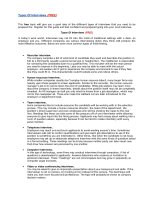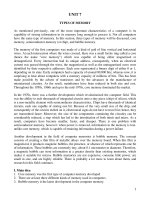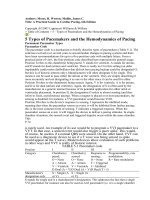types of rocks powerpoint
Bạn đang xem bản rút gọn của tài liệu. Xem và tải ngay bản đầy đủ của tài liệu tại đây (1.57 MB, 18 trang )
Liz LaRosa 2010
Images from Geology.com unless otherwise noted
A rock is a naturally occurring solid
mixture of one or more minerals, or
organic matter
Rocks are classified by how they
are formed, their composition, and
texture
Rocks change over time through
the rock cycle
Igneous rock begins as magma.
Magma can form:
▪ When rock is heated
▪ When pressure is released
▪ When rock changes composition
Magma “freezes” between
700 °C and 1,250 °C
Magma is a mixture of
many minerals
/>
Felsic: light colored rocks that are rich in elements
such as aluminum, potassium, silicon, and sodium
Mafic: dark colored rocks that are rich in calcium, iron,
and magnesium, poor in silicon
Coarse-grained: takes longer to cool, giving mineral
crystals more time to grow
Fine-grained: cools quickly with little to no crystals
Coarse-Grained: Cooled
slowly, underground
Fine-Grained: Cooled
quickly, at surface
Felsic:
Lightcolored
Granite
Rhyolite
Mafic:
DarkColored
Gabbro
Basalt
Intrusive Igneous Rocks: magma
pushes into surrounding rock below
the Earth’s surface, cools slowly with
larger crystal formation
Extrusive Rocks: forms when magma
erupts onto the Earth’s surface (lava),
cools quickly with very small or no
crystals formed
/>
Obsidian is a dark-colored volcanic glass that forms from the very rapid
cooling of molten rock material. It cools so rapidly that crystals do not form.
Is this rock Felsic or
Mafic?
Is it fine-grained or
coarse-grained?
Is this rock Intrusive or
Extrusive?
Mafic, fine grained, extrusive
Sedimentary rock is formed by erosion
Sediments are moved from
one place to another
Sediments are deposited in
layers, with the older ones
on the bottom
The layers become compacted
and cemented together
/>
Sedimentary Rocks are formed at or near the
Earth’s surface
No heat and pressure involved
Strata – layers of rock
Stratification – the process in
which
sedimentary rocks are
arranged in layers
Clastic – made of fragments of rock
cemented together with calcite or quartz
Breccia is a term most often
used for clastic sedimentary
rocks that are composed of
large angular fragments
(over two millimeters in
diameter).
The spaces between the
large angular fragments can
be filled with a matrix of
smaller particles or a mineral
cement that binds the rock
together.
Chemical sedimentary – minerals crystallize
out of solution to become rock
Limestone is a sedimentary rock
composed primarily of calcium
carbonate (CaCO3) in the form of
the mineral calcite. It most
commonly forms in clear, warm,
shallow marine waters.
It is usually an organic
sedimentary rock that forms
from the accumulation of shell,
coral, algal and fecal debris.
Organic sedimentary – remains of plants and
animals
Coal is an organic
sedimentary rock that
forms from the
accumulation and
preservation of plant
materials, usually in a
swamp environment.
Coal is a combustible rock
and along with oil and
natural gas it is one of the
three most important fossil
fuels.
Meaning to change shape
Changes with temperature
and pressure, but remains
solid
Usually takes place deep in
the Earth
/>
Contact Metamorphism – heated by nearby magma
Increased temperature changes the composition of
the rock, minerals are changed into new minerals
Hornfels is a fine-grained non-foliated
metamorphic rock produced by
contact metamorphism
igh&fr=t
Regional Metamorphism –
pressure builds up in rocks that is
deep within the Earth
Large pieces of the Earth’s crust
collide and the rock is deformed
and chemically changed by heat
and pressure
/>
Foliated - contain aligned grains of flat minerals
Gneiss is foliated
metamorphic rock
that has a banded
appearance and is
made up of granular
mineral grains.
It typically contains
abundant quartz or
feldspar minerals.
Non-Foliated – mineral grains are not arranged in
plains or bands
Marble is a nonfoliated metamorphic
rock that is produced
from the
metamorphism of
limestone.
It is composed
primarily of calcium
carbonate.
Determine if the following rock samples are foliated
or non-foliated:
Amphibolite
Quartzite
Phyllite
Foliated









